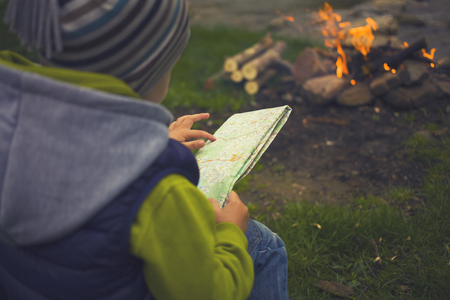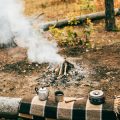1. Campfire Cooking Essentials
If youre new to campfire cooking, getting the right gear is the first step to making your outdoor meals a success. You don’t need fancy equipment—just the basics that are safe and practical for open-fire cooking. Heres a breakdown of the essential items youll want to pack before heading out.
Fire-Safe Cookware
Not all kitchen pots and pans are made for the heat of a campfire. Look for cookware labeled as fire-safe or campfire-friendly. Cast iron is a favorite because it distributes heat evenly and can handle high temperatures without warping. Stainless steel is also a solid option if youre looking for something lighter than cast iron.
| Cookware Type | Best For | Pros | Cons |
|---|---|---|---|
| Cast Iron Skillet | Pancakes, bacon, searing meat | Durable, even heating | Heavy, needs seasoning |
| Dutch Oven | Stews, chili, baking | Multi-purpose, retains heat well | Bulky, requires maintenance |
| Stainless Steel Pot | Boiling water, pasta, soups | Lighter than cast iron | Less heat retention |
Essential Utensils
You’ll need a few basic tools to prep, cook, and serve your meals around the campfire. Make sure these are heat-resistant and easy to clean.
- Tongs: Great for flipping food on the grill or handling hot foil packets.
- Spatula: Use a metal spatula for flipping burgers or pancakes on cast iron.
- Ladle or Large Spoon: Helpful when serving soups or stews.
- Cutting Board & Knife: A compact cutting board and sharp knife make meal prep easier at your campsite.
Heat Sources
The heart of any campfire meal is—of course—the fire itself. You have a few options when it comes to setting up your cooking heat source:
- Campsite Fire Ring: Most established campsites have fire rings that are great for cooking over an open flame or coals.
- Portable Fire Pit: Ideal if youre camping somewhere without built-in fire pits.
- Cowboy Grill Grate: Place this over your fire ring to hold pots and pans directly above the flames or coals.
Safety Equipment
Cooking over an open flame means you should always put safety first. A few basic items can help keep you safe while you cook:
- Fire-Resistant Gloves: Protects your hands from burns when handling hot cookware or adjusting logs.
- Fire Extinguisher or Bucket of Water: Always have something nearby in case you need to put out flames quickly.
- Tongs with Long Handles: Keeps your hands farther away from the heat while cooking.
- Splash Guard or Lid: Useful to control grease splatter and reduce flare-ups.
The right tools can make all the difference between a stressful experience and one thats fun and rewarding. With these essentials packed in your gear, youll be ready to try out simple meals and build confidence around the campfire!
2. Starting the Perfect Campfire
If you’re new to campfire cooking, getting your fire started the right way is key. A good cooking fire isn’t just about flames — it’s about building a safe, steady heat source that helps you cook evenly and safely. Let’s walk through how to build and maintain a campfire perfect for cooking.
Choosing a Safe Spot
Before striking that first match, make sure youre in a designated fire ring or pit — most campgrounds have them. If youre in a more primitive spot:
- Clear the area of dry leaves, twigs, or anything flammable within a 10-foot radius.
- Stay away from overhanging branches or tents.
- Keep a bucket of water and a shovel nearby for emergencies.
Selecting the Right Firewood
The type of wood you use matters when it comes to cooking over a campfire. Here’s a quick guide:
| Type of Wood | Best For | Avoid Because |
|---|---|---|
| Hardwoods (oak, hickory, maple) | Long-lasting coals and even heat | Can be harder to ignite without kindling |
| Softwoods (pine, fir, spruce) | Quick start-up and high flames | Burns too fast; can create lots of smoke and soot |
| Treated or painted wood | Never use for cooking! | Releases toxic fumes harmful to health and food |
Building Your Campfire
You’ll want your fire to burn down into hot coals for cooking. Try one of these easy methods:
Teepee Method (Great for Beginners)
- Create a small pile of tinder (dry leaves, bark, or paper) in the center.
- Add kindling (small sticks) around the tinder in a cone shape.
- Lean larger logs around the kindling like a teepee.
- Light the tinder and let it catch the kindling and logs naturally.
Log Cabin Method (Better for Longer Burns)
- Create a small teepee with tinder and kindling at the center.
- Stack two larger logs parallel on each side of the teepee.
- Add another layer of logs on top perpendicular to the first layer, creating a square shape like a log cabin.
- This structure gives more airflow and longer-lasting heat—perfect for cooking.
Maintaining Your Cooking Fire
- Let your fire burn down until there’s a solid bed of glowing coals — that’s your ideal cooking heat.
- Add small pieces of hardwood as needed to keep the temperature steady.
- Avoid large flare-ups by pushing unburnt wood to one side or using rocks to separate flame zones from coal zones.
Fire Safety Tips Every Beginner Should Know
- Never leave your fire unattended.
- Don’t use lighter fluid or gasoline – they’re dangerous and not food-safe.
- Douse your fire completely with water before going to sleep or leaving camp.
- If it’s windy or very dry, consider skipping the fire altogether and using a portable stove instead.
A well-built campfire sets you up for delicious meals under the stars. Take your time to do it right and always put safety first — both yours and nature’s.

3. Back-to-Basics Meal Planning
When youre new to campfire cooking, keeping your meals simple, nutritious, and satisfying is the key to a successful trip. You dont need fancy ingredients or complicated recipes to enjoy good food in the great outdoors. With a bit of planning, you can have delicious meals without stress.
Start with the Basics
Think about meals that are easy to prepare at home and translate well to outdoor cooking. Focus on whole foods like vegetables, proteins, grains, and healthy fats. One-pot meals, foil packet dinners, and skewers are great go-to options because they require minimal cleanup and work well over a fire.
Sample Campfire-Friendly Foods:
| Food Group | Examples |
|---|---|
| Proteins | Chicken, sausages, beans, eggs, tofu |
| Vegetables | Corn, bell peppers, onions, potatoes, zucchini |
| Grains/Carbs | Rice, pasta, tortillas, bread rolls |
| Dairy/Fats | Cheese, butter, olive oil |
Make-Ahead Tips
A little prep before you leave home goes a long way. Chop veggies, marinate meats, and pre-mix seasonings so you can spend more time enjoying nature and less time prepping at camp. Store ingredients in labeled zip-top bags or reusable containers for quick access.
Prep Ideas:
- Pre-chop veggies: Store in airtight containers or bags with a damp paper towel.
- Marinate proteins: Seal in bags with marinade and freeze them; they’ll thaw gradually in your cooler.
- Mix spices: Combine your favorite seasoning blends in small jars or baggies.
- Cook grains ahead: Cook rice or quinoa at home and reheat over the fire.
Portion Planning Made Easy
No one wants to run out of food—or carry too much extra. A good rule of thumb is to plan meals based on the number of people and servings needed per day. Adults usually need three full meals plus snacks. Kids may eat smaller portions but more frequently.
Basic Daily Meal Plan Per Person:
| Meal | Description |
|---|---|
| Breakfast | Oatmeal with fruit or scrambled eggs with toast |
| Lunch | Tortilla wraps with deli meat or peanut butter & jelly sandwiches |
| Dinner | Foil packet chicken with veggies or chili over rice |
| Snacks | Trail mix, granola bars, fresh fruit |
Pro Tip:
If youre camping for multiple days, try planning one “no-cook” meal (like sandwiches) to give yourself a break from the fire. Keep it light and simple!
A solid meal plan helps ensure youre well-fed and energized during your adventure—without lugging around unnecessary ingredients or wasting time figuring out what to cook next.
4. Easy Campfire Recipes for First-Timers
If youre new to campfire cooking, starting with simple recipes is the best way to build confidence and enjoy delicious meals outdoors. Here are some easy, beginner-friendly options that require minimal prep and gear, but deliver great flavor and fun.
Foil Packet Meals
Foil packet meals, also called “hobo packets,” are a campfire classic. Just wrap your ingredients in aluminum foil and cook them directly on the hot coals or over a grill grate. Theyre easy to customize and cleanup is a breeze.
Basic Foil Packet Recipe
| Ingredients | Instructions |
|---|---|
| Diced potatoes, carrots, onions, sliced sausage or ground beef, olive oil, salt & pepper | Toss all ingredients together in a bowl. Place mixture in the center of a large sheet of foil. Fold up the sides and seal tightly. Cook over hot coals for 20-30 minutes, flipping halfway through. |
Campfire Skewers (Kabobs)
Skewers are not only fun to make but also super versatile. You can use metal skewers or wooden ones (just soak wooden skewers in water for 30 minutes first).
Simple Chicken & Veggie Skewers
| Ingredients | Instructions |
|---|---|
| Chicken breast chunks, bell peppers, onions, cherry tomatoes, seasoning of your choice | Thread meat and veggies onto skewers. Season with salt, pepper, or your favorite spice blend. Grill over the fire for about 10–15 minutes, turning occasionally until cooked through. |
One-Pot Dishes
If you have a cast iron skillet or Dutch oven, one-pot meals are perfect for hearty campfire dinners with minimal mess.
Sausage & Rice Skillet
| Ingredients | Instructions |
|---|---|
| Sliced smoked sausage, instant rice, diced tomatoes (canned), chopped onion, olive oil | Heat oil in skillet over fire. Add sausage and onion; cook until browned. Stir in tomatoes and rice with equal parts water. Cover and simmer until rice is tender (about 10–15 minutes). |
Classic Campfire Dessert: S’mores
No camping trip is complete without s’mores! This sweet treat is an American tradition and super easy to make.
How to Make S’mores
| Ingredients | Instructions |
|---|---|
| Graham crackers, marshmallows, milk chocolate squares | Toast a marshmallow over the fire until golden brown (or gooey if you like it that way). Sandwich it between two graham cracker halves with a piece of chocolate. Let sit for a few seconds to melt the chocolate slightly—then enjoy! |
These easy recipes are perfect for getting started with campfire cooking. They’re tasty, low-stress, and sure to make your outdoor adventure even more enjoyable.
5. Cooking Techniques and Safety Tips
Getting the hang of campfire cooking doesn’t have to be complicated. With a few basic techniques and some safety know-how, you’ll be whipping up tasty meals in no time—even if it’s your first camping trip.
Grilling Over the Fire
Grilling is one of the easiest and most popular ways to cook over a campfire. All you need is a grill grate or a portable camp grill set up over the fire.
Tips for Grilling:
- Use hardwood like oak or hickory for better heat and flavor.
- Let the fire burn down to hot coals before grilling—flames can burn food fast.
- Oil the grate to keep food from sticking.
- Flip food with tongs, not a fork, to keep juices inside.
Roasting on Sticks or Skewers
This method is perfect for simple foods like hot dogs, sausages, or marshmallows. It’s great for beginners and kids love it!
Tips for Roasting:
- Use long metal skewers or whittled sticks (from safe, non-toxic wood like maple or birch).
- Hold food about 6 inches above the coals—not directly in the flames.
- Rotate slowly for even cooking.
Using a Dutch Oven
A cast iron Dutch oven lets you bake, simmer, stew, and more—all right over your campfire. Its super versatile and perfect for hearty meals like chili or cobbler.
Basic Dutch Oven Cooking:
| Cooking Style | How To Do It |
|---|---|
| Baking | Place hot coals under and on top of the lid evenly. |
| Simmering/Stewing | Keep most coals underneath; stir occasionally to avoid burning. |
| Searing/Frying | Add oil and heat Dutch oven directly over flame or coals. |
Food Safety Basics
Keeping your food safe while camping is just as important as cooking it well. Here are some simple rules to follow:
- Keep cold foods cold: Use coolers with ice packs. Don’t leave meat out in the sun.
- Cook meats thoroughly: Use a meat thermometer if possible. Chicken should reach 165°F (74°C).
- Avoid cross-contamination: Use separate utensils and cutting boards for raw meats and veggies.
Fire Safety Tips
A campfire is part of the fun—but also something to respect. Here’s how to manage your fire safely:
- Build fires only in designated fire rings or pits.
- Never leave a fire unattended.
- Keep water or sand nearby in case you need to put it out quickly.
- Douse the fire completely before going to bed or leaving camp.
Clean-Up Best Practices
A clean campsite keeps animals away and protects nature. After cooking:
- Scrape leftover food into trash bags—don’t bury it.
- Wash dishes with biodegradable soap at least 200 feet from any water source.
- Packed-in means packed-out: Bring all your trash home with you if there are no bins around.
Mastering these techniques and safety habits will make your campfire cooking experience safer, easier, and way more enjoyable!


